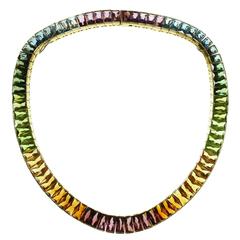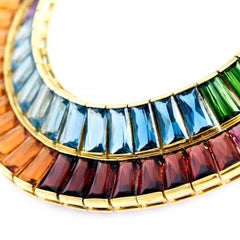H Stern Rainbow Necklace
Recent Sales
Vintage 1980s Brazilian More Necklaces
Amethyst, Citrine, Garnet, Peridot, Topaz, Tourmaline, 18k Gold, Yellow ...
Vintage 1980s Brazilian Retro Choker Necklaces
Amethyst, Citrine, Peridot, Tourmaline, Blue Topaz, 18k Gold
Vintage 1980s Contemporary Pendant Necklaces
Amethyst, Citrine, Diamond, White Diamond, Peridot, Topaz, Tourmaline, B...
H. Stern for sale on 1stDibs
Born into a Jewish family in Essen, Germany, Hans Stern (1922–2007) fled with his parents to Rio de Janeiro at the onset of World War II. There he landed a job working for the precious stone and mineral exporter Cristab. Thus began Stern’s rise to become “the king of the colored gems,” as the media would dub him, and founder of the family-owned H.Stern jewelry business that now has over 150 stores worldwide.
While working for Cristab, Stern regularly visited mines on horseback. At the remote mines of Minas Gerais, Brazil, he cultivated relationships with many of the miners, developing professional connections that would endure for decades. He also embraced a fascination with the colorful semiprecious stones harvested in the area. In 1945, he started his own company, H.Stern, with the goal of marketing Brazilian gemstones — then virtually unknown on the global stage — to an international audience.
Though the company began as a trader in gemstones, it soon expanded to jewelry, with Stern assembling and training a team of young jewelers. A frequent motif in the company’s designs was the star, as Stern is “star” in German. In 1949, H.Stern opened its first jewelry shop in Rio de Janeiro, but a storefront was not his customers’ only view into the brand’s jewelry-making process. In the 1950s, Stern became one of the first major jewelers to offer tours of his workshop, showing off the creative process and elevating the role of craftsmanship in jewelry design.
Stern’s approach and his vibrant jewels, which favored organic settings designed to show off colorful gems, earned international recognition and put Brazil’s topaz, amethyst and tourmaline on the map. Tourmaline was reportedly Stern’s favorite, and the company’s Rio de Janeiro vaults are also home to Paraíba tourmalines, which are mined in the mountains of Paraíba, Brazil. He recognized the burgeoning tourism industry in the country as an opportunity to promote the beauty of these stones, opening stores in the lobbies of Brazil’s leading hotels and investing in vehicles to bring visitors to the H.Stern headquarters. By the mid-1990s, the company was opening stores abroad and selling jewelry at international department stores.
In the 1980s, the brand debuted its first celebrity collaboration, with French actress Catherine Deneuve. Since then it has worked with partners such as designer Diane von Fürstenberg and architect Oscar Niemeyer. In 2016, Assouline published a book on the 70-year history of H.Stern, from its humble founding to its worldwide acclaim. Today, the company is run by Stern’s son, Roberto, who has introduced a broad range of new collections and styles.
On 1stDibs, find a collection of H. Stern necklaces, rings, earrings and other accessories.
Finding the Right necklaces for You
We are fortunate to know much of the world’s long and dazzling history of necklaces, as this type of jewelry was so treasured that it was frequently buried with its owners.
Lapis lazuli beads adorned necklaces unearthed from the royal graves at the ancient Iraqi civilization of Sumer, while the excavation of King Tut’s burial chamber revealed a sense of style that led to a frenzy of Art Deco designs, with artisans of the 1920s seeking to emulate the elegant work crafted by Ancient Egypt’s goldsmiths and jewelry makers.
In ancient times, pendant necklaces worn by royalty and nobles conferred wealth and prestige. Today, wearing jewelry is about personal expression: Luxury diamond necklaces exude confidence and can symbolize the celebratory nature of a deep romantic relationship, while paper-clip chain-link necklaces designed by the likes of goldsmith Faye Kim are firmly planted in the past as well as the present. Kim works exclusively with eco-friendly gold, and these fashionable, fun accessories owe to the design of 19th-century watch fobs.
For some, necklaces are thought of as being a solely feminine piece, but this widely loved accessory has been gender-neutral for eons. In fact, just as women rarely took to wearing a single necklace during the Renaissance, men of the era layered chains and valuable pendants atop their bejeweled clothing. In modern times, the free-spirited hippie and counterculture movements of the 1960s saw costume-jewelry designers celebrating self-expression through colorful multistrand necklaces and no shortage of beads, which were worn by anyone and everyone.
Even after all of these years, the necklace remains an irrefutable staple of any complete outfit. Although new trends in jewelry are constantly emerging, the glamour and beauty of the past continue to inform modern styles and designs. In a way, the cyclical history of the necklace differs little from its familiar looped form: The celebrated French jewelry house Van Cleef & Arpels found much inspiration in King Tut, and, now, their Alhambra collection is a go-to for modern royals. Vintage necklaces designed by David Webb — whose work landed him on the cover of Vogue in 1950, two years after opening his Manhattan shop — were likely inspired by the ornamental styles of ancient Greece, Mesopotamia and Egypt.
On 1stDibs, browse top designers like Cartier, Tiffany & Co. and Bulgari, or shop by your favorite style, from eye-catching choker necklaces to understated links to pearl necklaces and more.

